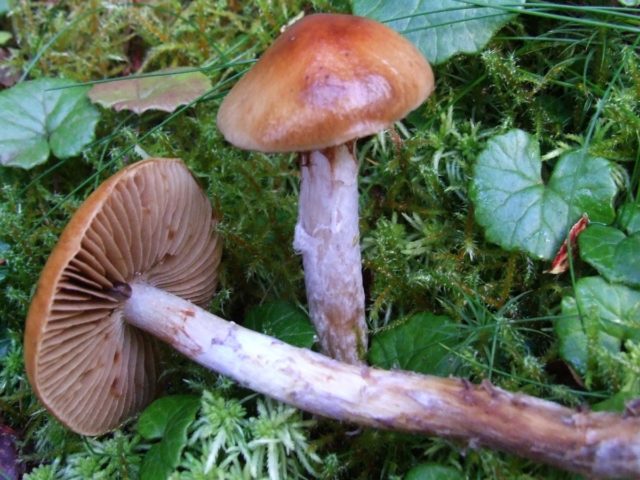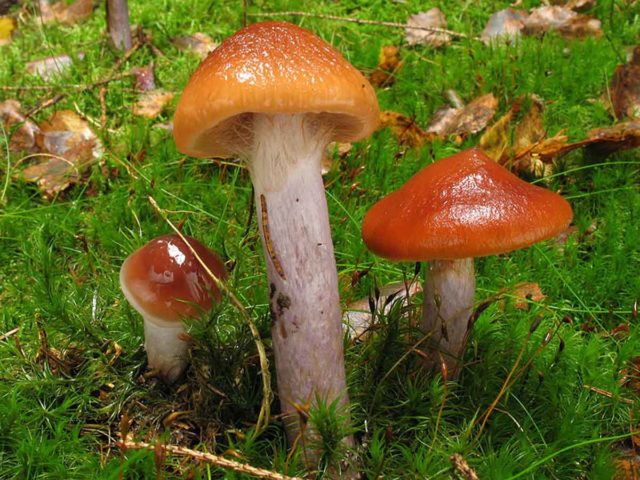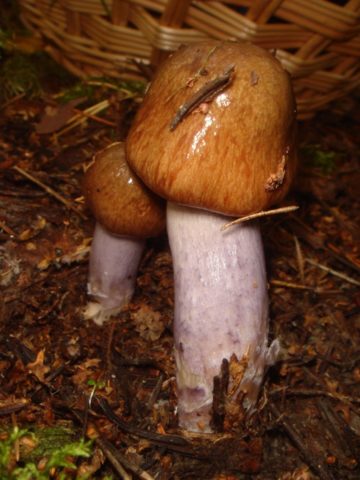Content
The webcap is soiling, straight, oiled, blue-bore - the names of one species, in biological reference books - Cortinarius collinitus. Lamellar mushroom of the Spiderweb family.

The plates are light brown with dark blotches
Description of the dirty webcap
An unfamiliar species for mushroom pickers that is not popular. Outwardly, it resembles inedible mushrooms, so it is rarely seen among the harvested crop. The color of the fruiting body is variable. At the initial stage of development, it is brown with a reddish tint, then it becomes closer to a yellow-orange color. In mature specimens, it brightens to beige with a yellowish tinge.

The upper part of the blue-bore webcap is much darker than the lower
Description of the hat
The spider web is of medium size, the diameter of the cap in adult specimens reaches 10 cm. The color of the central part is dark, the edges are lighter. In a young spider web, longitudinal asymmetric stripes can be observed.
External characteristic:
- at the beginning of growth, the shape of the cap is bell-shaped with a tight-fitting blanket;
- in more mature fruiting bodies, it becomes convex with a distinct tubercle in the center;
- in the final stage of the growing season, the cap becomes prostrate with concave smooth or slightly wavy edges;
- a dense coverlet breaks, remains in the lower part in the form of a grayish cobweb;
- the surface is even in young mushrooms, small tuberous in adult specimens;
- the protective film is mucous, dries up at low humidity, becomes hard matte;
- the plates are tightly fixed, the arrangement is sparse, in young specimens their color is light with a bluish tinge, then they darken to brown.
The pulp is dense, whitish, without a pronounced odor.

The surface is sticky, often with particles of fallen leaves or twigs
Leg description
The leg is solid inside in young specimens, hollow in mature specimens. Cylindrical, 10 cm high, 2 cm wide. Central erect, slightly curved at the top. Thinner at the base than near the cap. With obvious remnants of the bedspread and descending blades at the beginning of the growing season. Near the mycelium, the leg is painted in ocher color. Often on its surface, especially in dry weather, scaly rings of a darker color are determined.

The surface is smooth, mucous, the main tone is white with a grayish or bluish tint
Where and how it grows
The dirty webcap is not a rare species, it is widespread in the central regions, Siberia, the European part, the Urals. In the Far East, it is found, but much less often. It forms a symbiosis only with aspens, therefore it can grow in any type of forest where this tree species is found. Medium-late fruiting - from July to September, grows singly or in scattered small groups.
Is the mushroom edible or not
The dirty webcap is an edible mushroom of the fourth category. The fruiting body is odorless and tasteless.
Doubles and their differences
The peacock cobweb is referred to as the twins of the dirty webcap. More often found in the European part, it creates mycorrhiza with beech. The surface of the cap is large-scaled, brick-colored. The leg is colored unevenly, dark brown fragments predominate. Inedible species with toxic compounds in the chemical composition.

The remains of the bedspread are absent, the flesh turns yellow on the cut
Conclusion
Staining webcap is an edible mushroom, odorless and tasteless. Suitable for all cooking methods, but pre-heat treatment is required. Fruiting from late summer to September.








